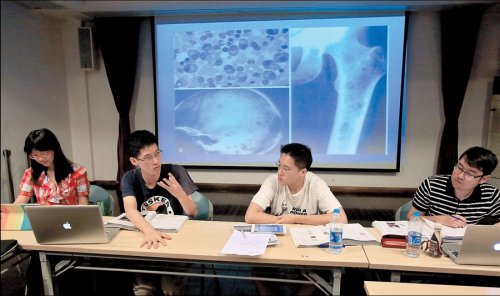
“Grey’s Anatomy,” the popular United States
television series, is becoming a reality show for Shanghai medical
students who want to become doctors in the US, but none will have
the time watch it now.
They are too busy preparing for the United States Medical
Licensing Examination, which is believed to be the most difficult
professional standardized test in the world.
It consists of three steps, and two must be conducted in the US.
The television series takes its name from Gray’s Anatomy, a
classic English language textbook of human anatomy originally
written by Henry Gray and published in 1858. No doubt the latest
edition of the book sits somewhere in the stack of materials
students need to help them pass the exam.
After passing Step 2, applicants and hospitals recruiting
resident physicians go through a matching procedure after
interviews. Each side lists its preferences and a computer decides
which applicants should go to which hospitals for residency.
Gao Shan flew to the US in late June after being recruited by the
University of Toledo Medical Center.
“No matter where I end up, the experience of taking the exam and
being trained in the US will always be treasured,” she said. “The
knowledge and skills I learn will always be with me, and, more
importantly, I will see the world from a different point of view.”
Gao is a founding member of the Shanghai USMLE Group, an
organization named after the exam. It was established in 2009 by
students from medical schools at Fudan and Jiao Tong universities
to share experiences and academic materials related to the exam.
Why are some Shanghai medical students keen to go abroad to
practice?
Heavy workloads and low pay in Chinese hospitals are believed to
be major contributing factors. But some medical students simply
said they believe working in hospitals in more developed countries
will enhance their professional credentials and make them better
doctors. Many of them say they will return to China one day,
bringing those advanced skills back with them.
Gao said the US licensing exam takes a long time and a lot of
energy to prepare for. The interviews and matching process are just
hurdles, and then the hard work of actual resident practice begins.
“But if you go through all this, you emerge a whole new person,
much stronger and more mature than you have ever dared to imagine,”
she said. “I‘m not saying residency in the US is the only right way
to go or is somehow superior. But if we believe the status quo in
China needs to be changed, then we need to be the agents of that
change.”
Strongly encourage
There are thousands of medical students majored in clinical
medicine at medical schools of Jiao Tong, Fudan and Tongji
universities and the Second Military Medical University in
Shanghai, but no estimates on how many of them are planning to take
overseas exams for residency. USMLE members said about 30 percent
of medical students may think about taking the exam, but less than
10 percent actually proceed.
Fewer than 10 students took part this year, a member said.
Officials at Jiao Tong’s medical school strongly encourage
students to take the exam.
“We are not afraid of losing our top students,” said Huang Gang,
the school’s director. “With Shanghai’s development, we will need
more medical talent with international backgrounds and outlooks.
Having 10 of our 100 students go abroad and then come back and
serve local hospitals is better than having no one going abroad.”
Currently, the USMLE Group has about 50 members from medical
schools in major local universities. Anyone who wants to join must
first read four books required for the test and do a presentation
of their medical studies and goals. Applicants need to show
dedication and determination and must be recommended by two
existing group members.
“Preparing for the exam is a big challenge and we want to make
sure every member takes it seriously,” said Jerry Zhang, a medical
student at Jiao Tong, who plans to take the test next February.
“Preparation means sacrificing almost all your free time,” he
said. “Much of the knowledge demanded in the test is not fully
taught at our own medical school, or is taught from a different
perspective.”
The group meets every Sunday afternoon. Two members are
designated to give speeches on two medical topics at each meeting.
Discussion follows.
“Group discussions allow us to learn quickly and sometimes more
efficiently than just reading books alone,” Zhang said.
He explained why the exam is so difficult.
Step 1 is an eight-hour multiple-choice exam, taken on computer,
to assess an applicant’s knowledge in basic sciences related to
medicine.
The test can be taken in or outside the US. In China’s mainland,
it is available in Shanghai, Guangzhou or Beijing.
Step 2 includes a nine-hour multiple-choice examination on
clinical knowledge and a test on clinical skills with standardized
patients. The latter part is offered only in five cities in the US.
Step 3, the final one, is a 16-hour computerized examination
divided over two days in the US. It is usually taken during
residency.
Yang Zhang, a PhD student at his sixth year of medical school at
Jiao Tong, just returned from Los Angles, where he completed his
second part of Step 2 exam in May.
“Each examinee had 15 minutes to complete history-taking and
clinical examination of each of 12 sample patients, and 10 more
minutes to write a patient note describing the findings, initial
differential diagnosis and a list of initial tests,” he said.
“Patients score each examinee on our outlook, attitude, English and
professional skills.”
He added, “It was an enlightening experience, and I am fully
ready to practice in the US and come back to China as a top doctor
in the future.”
原文链接:http://www.shanghaidaily.com/metro/education/Diagnosing-why-medical-students-look-to-US/shdaily.shtml

